Cayman Islands’ housing market robust, with good yields, and limited supply
After several challenging years, the Cayman Islands’ property market is growing again rapidly.
“We are into unchartered territory in the property market,” said Simon Watson of Charterland. “The market has recovered from the downturn of 2010 and is now way beyond the previous peak.”
Growth is centered along Seven Mile Beach for condominiums, and Cayman Kai, on the island’s north, for single-family homes. The most expensive housing is along Seven Mile Beach, a coral-sand beach on the western end of Grand Cayman island. Property prices can reach as high as KYD1,500 (US$1,800) per square foot (sq. ft.). Prices surged 33% in 2018.
- At The Pinnacle, a luxury beachfront development on Seven Mile Beach, the average condominium sales price was KYD2.37 million (US$2.82 million) in 2018, up 25%, according to Charterland, Ltd;
- At the Regal Beach Club, a beachfront condominium development of 57 units on Seven Mile Beach, the average sales price rose in 2018 by 19% to KYD951,300 (US$1.13 million).
- At George Town Villas, another Seven Mile Beach seafront development of 60 condo units, sales prices increased 28% y-o-y to KYD655,500 (US$780,300).
- In George Town’s Garden, Coco, Mystic and Sunset Retreat, two-bedroom inland townhouses´ prices rose 21% to about KYD247,400 (US$294,600) in 2018.
In 2018 property transfers on the open market were up 9% to 857, the highest level since 2005, according to Charterland, Ltd, with transaction values up 17.8% to KYD800 million (US$962.3 million). However in the first nine months of 2019, freehold property transfers fell both in number and value by 8.3% and 11.4%, respectively, due to limited supply.
Residential construction is falling. In Grand Cayman, residential building permits fell by 10% in 2018 from a year earlier. The total value of permits for houses was down by 13.3% and by 4.3% for apartments and condominium units. Likewise, approved applications fell by 15% to KYD 286.65 million (US$344.8 million) in 2018.
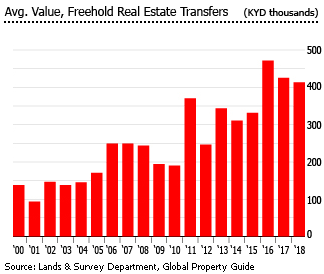
During the past decade, the movement of the average value of property transfers has been erratic because large-scale acquisitions by property developers distorted the market. For instance in 2011, Dart Group made significant acquisitions representing about 28% of the total value of all property transfers.
There are no restrictions on foreign ownership of property in the islands. The absence of taxes and restrictions on foreign ownership of land makes investing in the Cayman Islands very attractive.
Land values are rising
Land prices continue to increase strongly in the Cayman Islands.
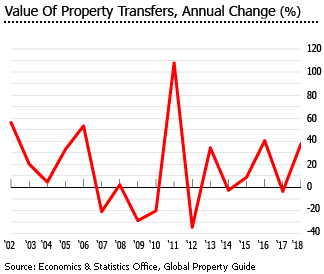
In 2018:
- At the Crystal Harbour, the average price of high-end canal-front lots sold increased 7% y-o-y to KYD32.27 (US$38.82) per square foot (sq. ft), according to Charterland, Ltd.
- At the Grand Harbour, the average sale price of high-end canal-front lots surged 33% to KYD27.73 (US$33.36) per sq. ft. from the previous year.
- In the mid-range area of Savannah, the average sale price of residential lots rose by 22% from a year earlier, at KYD6.62 (US$7.96) per sq. ft.
- In the lower-end area of Frank Sound, the average sale price of residential lots fell by 4% y-o-y to KYD3.3 (US$3.97) per sq. ft.
- In Cayman Brac Bluff areas, undeveloped residential lots were sold for an average price of KYD2.12 (US$2.55) per sq. ft., the first time that it has surpassed the KYD2 mark since 2013.
Residential construction activity declining
In Grand Cayman, residential building permits fell by 10% in 2018 from a year earlier, according to Cayman Islands Planning Department.
- The value of permits for houses in Grand Cayman fell by 13.3% y-o-y to KYD93.5 million (US$112.27 million) in 2018 from a year earlier.
- The total value of building permits for apartments in Grand Cayman dropped 4.3% y-o-y to KYD59.8 million (US$71.81 million) over the same period.
Likewise, the value of approved developments in Cayman Islands declined by 5.8% y-o-y to KYD 752.3 million (US$ 903.4 million) in 2018. Approved residential applications fell 15% to KYD 286.65 million (US$344.8 million).
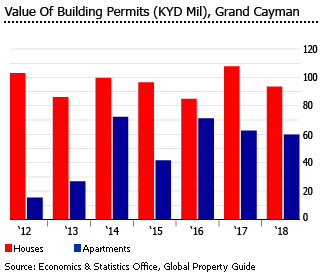
The highest value of project approved last year was the Olea residential development by NCB Development at KYD 37.52 million (US$ 45.13 million).
Demand remains robust
The highest value property sales recorded in 2018 include:
- Seven Mile Beach condominium development site, measuring 2.88 acres: sold for KYD45.78 million (US$54.5 million)
- Holiday Inn Resort (former Grand Caymanian Hotel): sold for KYD15.6 million (US$18.6 million)
- Ritz-Carlton Residences: a residential property was sold for KYD8.15 million (US$9.7 million)
- Seare Residences: a residential property was sold for KYD5.83 million (US$6.94 million)
- A 10,400-sq. ft. single family dwelling located on a 1.4 acre beachfront site on South Sound: sold for KYD4.96 million (US$5.91 million)
However from January to September 2019, total freehold property transfers fell by 8.3% at 1,447 units, compared to the same period last year, according to Cayman Islands’ Lands and Survey Department.
“This would indicate that the decrease in the number of sales is a result in a lack of inventory rather than diminishing demand,” noted Charterland, Ltd adding that prices in the Seven Mile Beach continue to soar.

At least 75% of homebuyers in Cayman Islands come from the United States and Canada. There is also a growing interest from Europeans and South Americans.
The rise of canal-front properties
Recently, there has been increased interest in canal-front homes, both from home buyers and property developers, according to the Cayman Islands Real Estate Association Brokers (CIREBA). They are more affordable then oceanfront properties, yet offer incredible views to home owners.
Canal-front homes are now under construction along the Seven Mile Beach corridor stretching up to West Bay, primarily on land south of the Ritz-Carlton, Grand Cayman, and land to the north of the Yacht Club and land at Camana Bay. Another example is that of Safe Haven, though the canal-front properties there are leasehold.
One Canal Point recently broke ground on a canalfront development site opposite Foster’s Food Fair, which includes 17 townhomes, 38 one-bed apartments, and 19 two-bed apartments. Prices range from US$600,000 to US$1.6 million. It is scheduled for completion in 2021.
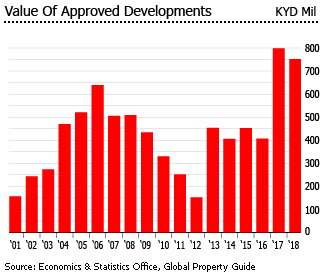
There are at least 20 canal residential subdivisions in Grand Cayman, half along the Seven Mile Beach and West Bay, and the other from Prospect to North Sound Estates and the Cays in Rum Point.
Canal subdivisions can be divided into five levels, depending on price and quality.
- Level 1 - the most expensive, with strong covenants and manned security gates. These include Vista Del Mar, Salt Creek, and Camana Bay, with land values ranging from KYD457,000 (US$550,000) to KYD2.5 million (US$3 million).
- Level 2 - luxury homes with strong covenants but unmanned security gates. These include Crystal Harbour, Crystal Cove, Cypress Pointe North, Britannia, and the redeveloped Cayman Islands Yacht Club, with land values ranging from KYD308,000 (US$370,000) to KYD831,000 (US$1 million).
- Level 3 - well-maintained upper-middle class luxury homes with good covenants. These include Canal Point, the Shores and Mangrove Point, the Grand Harbour, the older and more developed side called South Reach, The Isles, The Estates, Patrick´s Island, and Sunrise Landing, with land prices ranging from KYD249,400 (US$300,000) to KYD498,800 (US$600,000).
- Level 4 - mixed mid-level homes with decent services, including older subdivisions like Red Bay, Omega, and Prospect and newer developments such as Newlands Sound, Palm Heights in Snug Harbour. Land values range from KYD124,700 (US$150,000) to KYD299,300 (US$360,000).
- Level 5 - mid- to low-level homes with minimal maintenance, such as the North Sound Estates and Red Bay Prospect. Land values range from KYD103,900 (US$125,000) to KYD166,300 (US$200,000).
Mortgage interest rates gently rising
In 2018, the average interest rate on loans stood at 7.72% in 2018, up from 7.58% in 2017, 7.01% in 2016, 6.96% in 2015 and 6.59% in 2014. Mortgage interest rates in the Cayman Islands are typically tied to the prime rate set by the Cayman Islands Monetary Authority (CIMA), which follows the US Fed funds rate, but are one or two percentage points above the current prime rate. The Cayman Islands dollar (CI$) is pegged to the US dollar at CI$1 = US$1.20.
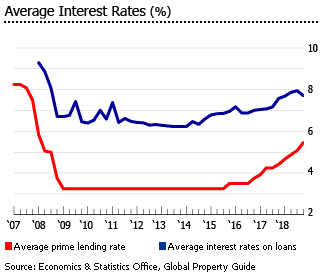
The maximum loan-to-value (LTV) ratio is 70% of the property´s appraised value, with a maximum term of around 10 to 15 years. However, Caymanians are offered longer periods of between 30 to 40 years. The minimum loan amount is US$100,000. In 2018, the average foreclosure rate dropped to 1.6%, from 2.1% a year ago.
Mortgage market shrinking
In recent years the mortgage market has shrunk to just 39.9% of GDP in 2018, from almost 60% of GDP in 2012, despite the continuous growth in the total value of outstanding property loans to households.
Good rental yields of 7.5% to 8.2%
Cayman Islands offer good rental yields, ranging from 5%-7% along the Seven Mile Beach to 7.5%-8.2% in other beach communities in Grand Cayman, based on Global Property Guide research.
That´s because the Cayman Islands’ rental market is expanding as the population rises, and more companies have offices in the island´s special economic zone, Cayman Enterprise City. In 2018, about 47% of households in Cayman Islands rented their dwellings, up from 41.5% seven years ago, according to the Economics and Statistics Office.
The rental market is tight, especially near Seven Mile Beach in Grand Cayman, the islands´ most expensive area according to Capital Realty. A two and three-bedroom condominium unit on Seven Mile Beach rents for about KDY2,100 (US$2,500) to KDY4,600 (US$5,500) per month.
Apartment complexes on Seven Mile Beach offering long-term rentals include George Town Villas, The Grandview, Sunset Cove, Seagull Condominiums, Laguna del Mar, Lacovia, The Sovereign and The Pinnacle. Currently, monthly rents range from KYD2,000 (US$2,400) to KYD9,000 (US$10,800).
The Terraces, located in the Camana Bay, also offers 63 apartments for long-term rental, with monthly rents starting from KYD2,100 (US$2,500) for a one-bedroom unit.
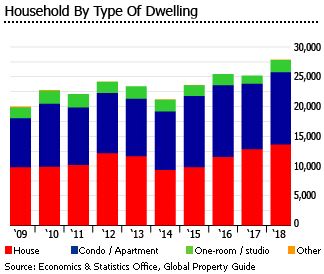
Upscale residential areas outside Seven Mile Beach include the South Sound, a posh area close to schools, and George Town. The monthly rent of two-bedroom apartments across the road starts at KYD1,500 (USD1,800) while those on the sea are rented from KYD2,000 (USD2,400) to KYD4,600 (USD5,530).
In the Old Crewe Road, monthly rent of two-bedroom apartments in the Sunrise Apartments, Pine Crest Apartments and Elizabeth Villas starts from KYD1,400 (US$1,700), though some newer, more exclusive condominiums rent from KYD2,000 (US$2,400) to KYD2,500 (US$3,000) per month.
Other areas in Cayman Islands popular with families and professionals include Jennifer Drive, Andrew Drive, Palm Heights Drive, Canal Point Drive, Parkway Drive and Whitehall Estates.
Tourism remains strong
Tourism accounts for around 30% of the islands’ GDP. Tourist visits from the United States and Canada continue to increase. In 2018, total visitor arrivals rose by 11% y-o-y to a record 2.38 million people, according to the Cayman Islands´ Department of Tourism.
During the first three quarters of 2019, stay-over visitors rose by 10.3% to 386,290 tourists from the same period last year. Over the same period, cruise arrivals fell by 5.9% to 1,332,159 tourists. The United States accounted for more than 84% of all stay-over arrivals in Cayman Islands during the period.
Total visitor spending increased 8% y-o-y to US$ 700.9 million in the first three quarters of 2019. Cayman Islands recently topped 7,000 total accommodation units.
“It is reaffirming to hear first-hand the positive impact our stayover strategy is having on stimulating tourism businesses’ profit margin during what we consider traditional shoulder season,” said Minister of Tourism, the Hon Moses Kirkconnell.
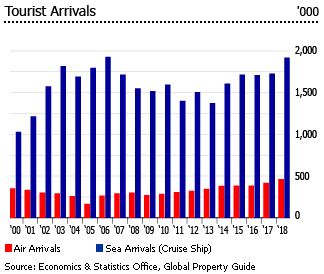
To attract more visitors, the government has been improving its infrastructure and flight access, opening a brand-new airport terminal in Grand Cayman. In addition, several new hotels are being built, ranging from Mandarin Oriental’s second Caribbean hotel to a new Grand Hyatt-branded residential resort and a Hilton project.
The introduction of medical tourism has attracted tourists in the past several years. The Narayana Cayman University Medical Center, a 500-acre, 2,000-bed medical school and hospital complex opened its first phase, a 200-bed hospital, in August 2012, attracting medical tourists from America, from South and Latin America and the Caribbean.
Modest economic growth, falling unemployment
The Cayman Islands is one of the most affluent countries in the Caribbean. Thanks to its twin pillars of development, tourism and international finance, this British overseas territory enjoyed average real GDP growth of 3.1% annually from 1998 to 2007. The country is the world´s sixth largest banking center.
"Cayman is a First World country in the Caribbean with a large international business community and well developed, diverse facilities including hospitals, schools, golf courses and hotels," says Charles Weston-Baker of Savills.
From 2008 to 2010, the spillover effects of the global financial meltdown caused real GDP to fall by 7% in 2009 and another 2.7% in 2010. The economy finally recovered in 2011, with a real GDP growth rate of 1.2%. However economic growth has been modest since then. Economic growth averaged 2.4% from 2012 to 2017.
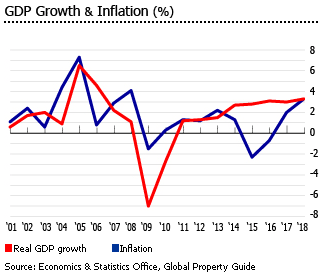
In 2018, the economy grew by 3.3%, up from the prior year’s 3% growth and the highest expansion since 2006, according to the Economics and Statistics Office (ESO).
In Q1 2019, nationwide inflation rate stood at 4.5%, up from 1.7% in the previous quarter and 3.2% a year ago, according to ESO.
Unemployment was 2.8% in 2018, sharply down from 4.9% in 2017 and the lowest level since 2006.
Sources:
- Cayman Property Review 2018 (Charterland Ltd.): http://www.charterland.ky/wp-content/uploads/2019/03/CPR-charterland-2018-web-final.pdf
- Rental incomes in Cayman Islands - good rental yields, ranging from around 5% to 8.2 % (Global Property Guide): https://www.globalpropertyguide.com/Caribbean/Cayman-Is/Rental-Yields
- New 74-home canalfront development planned (Cayman Compass): https://www.caymancompass.com/2019/04/29/new-74-home-canalfront-development-planned/
- The Cayman Islands Is Seeing Record-Breaking Tourism Growth (Caribbean Journal): https://www.caribjournal.com/2019/05/06/cayman-islands-record-tourism/
- 9 Month Destination Snapshot January – September 2019 (Department of Tourism): https://www.visitcaymanislands.com/Visitcaymanislands.com/media/Documents/2019-9Month-Snapshot.pdf
- The Cayman Islands’ Annual Economic Report 2018 (The Economics and Statistics Office): https://www.eso.ky/UserFiles/page_docums/files/uploads/the_cayman_islands_annual_economic_repor-2.pdf
- The Cayman Islands’ Compendium of Statistics 2018 (The Economics and Statistics Office): https://www.eso.ky/UserFiles/right_page_docums/files/uploads/the_cayman_islands_compendium_of_statist-10.pdf
- Lands & Property Transfers / Leases (Land & Survey Department): http://www.caymanlandinfo.ky/AboutUs/Statistics/2019Statistics/tabid/269/Default.aspx
- Property sales hit new record amid real estate boom (Cayman Compass): https://www.caymancompass.com/2019/03/10/property-sales-hit-new-record-amid-real-estate-boom/
- Cayman Islands: Performance indicates sustained tourism growth (eTurbo News): https://www.eturbonews.com/450283/cayman-islands-performance-indicates-sustained-tourism-growth/
- Travelers Are Flocking to the Cayman Islands (Caribbean Journal): https://www.caribjournal.com/2019/11/24/cayman-islands-tourism-flocking/